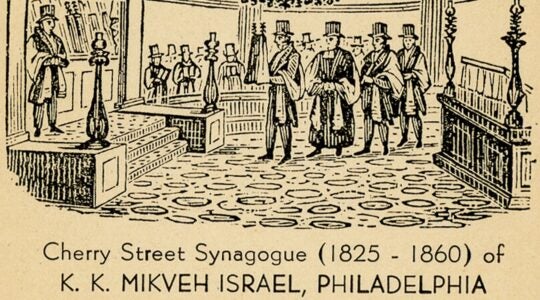LOS ANGELES (JTA) — As we approach Martin Luther King Day, as many Jews celebrate the election of the nation’s first African-American president, we find ourselves in a good place to take a "devar acher," a fresh look at our relationship with the black community and how we welcome others into our own.
This fresh look begins in antiquity.
King’s speeches were rooted often in the words and visions of the prophets. When he said "I have a dream that one day every valley shall be exalted, every hill and mountain shall be made low," he was presenting a nearly verbatim quote from Isaiah 40. How can these words connect us to a 2,000-year-old tradition of loving our neighbors and pursuing justice?
Jewish tradition drives home more than any other concept that we welcome and befriend the ger, the stranger — those not of our faith or community. As it is says in Deuteronomy, "You too must befriend the stranger, for you were strangers in Egypt." The Torah cites the need for awareness of and justice for the stranger 36 times, more than any other mitzvah.
For most of us it is a far easier concept to read than to follow. In our schools, associations, working groups, trade shows and clubs, African Americans, Latinos, Asians and immigrants are sighted only rarely.
Perhaps what is needed to get us in the welcoming mode and mood is a new holiday.
Judaism has a genius for crystallizing concepts through holidays: Passover, freedom; Chanukah, light; Sukkot, joy. As a co-celebration of Martin Luther King Day, let me propose — as a way of adding inclusion to our lives — a day dedicated to welcoming the stranger: Yom Ha’Ger.
Inspired by the Torah and reflected in King’s words to "speed up that day when all of God’s children — black men and white men, Jews and gentiles, Protestants and Catholics — will be able to join hands and sing," Welcome the Stranger Day will add a new trope of song between Chanukah and Purim.
Shouldn’t a concept mentioned twice chai times in the Torah have its own holiday?
New seders? Ritual objects, noshes or songs? Should the holiday be synagogue or home centered? How do we celebrate this day to welcome the stranger?
In the tent of Abraham we find an answer.
In Bereshit, the Book of Genesis, Abraham sits at his tent’s entrance at the hottest part of the day and welcomes three strangers. He bows, offers water to bathe their feet and in a great rush prepares for them a four-star meal of finest flour and personally selected meat.
This is a critical moment in our history, since the strangers bring news that Sarah will have a child and Abraham an heir. The three strangers are welcomed as guests. Hospitality, "hachnasat orchim," is central to our story.
So for our new holiday, do we all need to buy a tent or simply enlarge the one we already have? What is essential is that it have an open door and an open-door ritual. Something Elijaesque like at the end of the Passover seder — except these guests actually enter, pull up a chair and join you for a meal.
Yom Ha’Ger also should have a communal aspect.
I live in an urban neighborhood that is multiracial and multilingual, not a rarity in Los Angeles. What is rare is its cohesiveness. Located a few miles west of downtown, it’s a mixture of Korean, African-American, Caucasian and Latino households. No one group owns the tent.
Each group, at first a stranger, has learned in turn to welcome the newcomer. There is a Korean language insert in the area’s newsletter; flyers are translated into Spanish; and a display featuring African Americans who helped establish the area is exhibited at a yearly event.
Mormons, Catholics, Buddhists, Muslims, Jews, Protestants, gay and straight households all have joined hands to maintain and preserve the neighborhood. This suggests that on Yom Ha’Ger, to recall this and other community victories, we stand arm in arm, singing together from psalms, "Hine ma tov uma naim shevet achim gam yachad," "Behold, how good and how pleasant it is for brethren to dwell together in unity."
My neighborhood wasn’t always so diverse. Until the late 1940s, each property had a restrictive covenant, common in Los Angeles, prohibiting its sale to nonwhites. It would take a unique meeting of blacks and Jews to change this.
As reported in a 2007 story in the Los Angeles Times, in 1947, with the covenants still in effect, three African-American families — the Drys, Stricklands and Stewards — purchased homes here and were soon sued by nine white neighbors.
Superior Court Justice Stanley Mosk, a Jewish supporter of civil rights and a future California Supreme Court justice, dismissed the lawsuit, ruling that the covenants were not enforceable.
Yom Ha’Ger, like many holidays, needs its heroes. On that day, to remember those who opened the door we embroider a mizrach, a wall hanging that shows us the direction in which to pray, with the words "tzedek, tzedak tirdof," "Justice, justice shall you pursue."
How do we conclude our new holiday?
Where we usually begin, by singing "Mah Tovu": "How goodly are your tents O Jacob." Except on this day while we sing, in the spirit of welcoming and Dr. King, we motion for others to pitch their tents as well.
(Edmon J. Rodman is a Los Angeles writer and designer. He is a former president of the Country Club Park Neighborhood Association.)
JTA has documented Jewish history in real-time for over a century. Keep our journalism strong by joining us in supporting independent, award-winning reporting.





